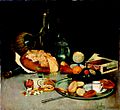José Navarro (painter) facts for kids
Quick facts for kids
José Navarro
|
|
|---|---|
| Born |
José Navarro y Llorens'
1867 Valencia, Spain
|
| Died | 1923 aged 56-57 Valencia
|
| Nationality | Spanish |
| Education | San Carlos Art Academy, Valencia |
| Known for | Painting |
| Movement | Orientalist |
José Navarro y Llorens (born 1867, died 1923) was a Spanish painter. He was known for his paintings of places in the Middle East (called Orientalist art), still lifes (paintings of objects), and landscapes from his home region of Valencia.
Contents
Life of a Painter
José Navarro y Llorens was born in 1867 in Godella, a town near Valencia, Spain. He studied art at the San Carlos Academy in Valencia. He loved Valencia and stayed connected to it his whole life.
Around 1920, he lived in Madrid. He traveled a lot through Europe and North Africa. This helped him learn more about art. When he was young, he visited Morocco. In Morocco, he became very interested in painting scenes from the Middle East. Navarro admired another painter named Mariano Fortuny. Fortuny might have inspired him to travel to Morocco.
Navarro was a friend of the artist Pinazo Camarlench. Like Pinazo, Navarro painted many landscapes. But Navarro also painted seascapes (scenes of the sea), Orientalist themes, and people. He especially liked to paint gypsies and Moroccans. His art was influenced by famous Spanish painters like Mariano Fortuny and Joaquín Sorolla.
Because of his great talent, Navarro was seen as one of the best painters from the Valencian School. In 1908, he traveled to Rio de Janeiro, Brazil. He showed his paintings there and received much praise.
Navarro died on February 6, 1923, in Valencia.
What He Painted
Navarro's Orientalist paintings often used short brush strokes. This gave them an impressionistic style, making them look like a quick impression of a scene. He often painted seascapes, showing exciting events at sea. These kinds of events were common in Spain in the 1890s.
For example, he painted a scene of a shipwreck from 1894. This painting is now in the Carmen Thyssen Museum in Malaga. It might be the same painting that won an award at a big art show in 1895. Another painting at that museum is Arrival of Fishing (1904-1910). This work was inspired by Joaquín Sorolla's La Vuelta de la Pesca (1894), which is in Paris. Navarro was skilled at painting with both oil paints and watercolors.
Some of his famous paintings:
- El Zoco (The Market at Tangier)
- Toros (Bulls)
- La Plaza Redonda (The Round Square)
- Escena En La Playa (Beach Scene)
- En El Puerto (At the Port)
- Playa con Barcas Varadas (Beach with Abandoned Boats)
- Gitanillos (Gypsy Children)
- Calle Morocaine (Moroccan Street), in a private collection
- Bab-Ftouh, Fes (Bab-Ftouh, Fez)
- Evocación de Marruecos (Impression of Morocco), in the Prado Museum, Madrid
Gallery
See also
 In Spanish: José Navarro Llorens para niños
In Spanish: José Navarro Llorens para niños
- List of Orientalist artists
- Orientalism










